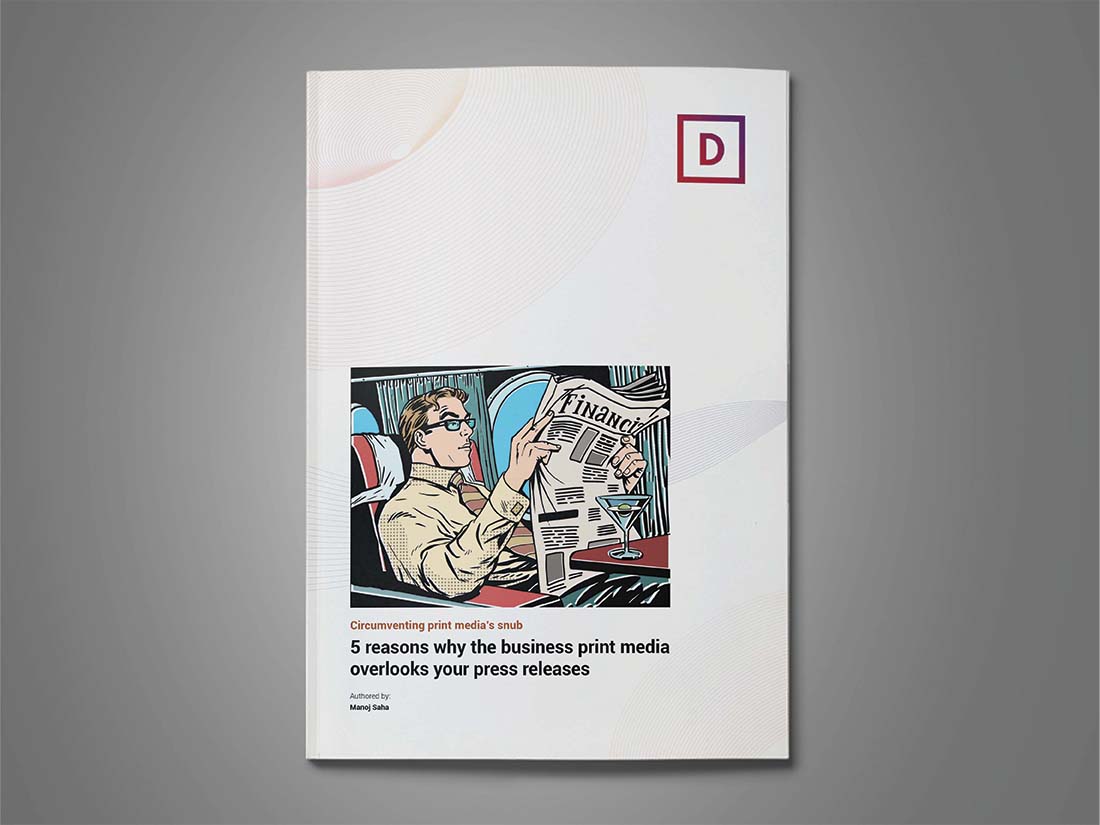Circumventing print media’s snub
5 reasons why the business print media overlooks your press releases
For some inexplicable reasons, many CXOs still cling on to an outdated notion that their stakeholders consume information on them mainly through a few leading business newspapers. This misconception has resulted in an endemic OCD (Obsessive Compulsive Disorder) within Corporate India for craving coverage in the printed business dailies. There are many structural reasons why such newspapers often tend to overlook corporate press releases. We explore the key reasons behind this dissemination blockade, and how you can circumvent this?
Many companies still latch on to an expired idea that assumes that their stakeholders consume information and read news about them only through a few business newspapers. This notion has resulted in an endemic OCD (Obsessive Compulsive Disorder) amongst Corporate India for getting featured in business dailies.
India is one of the few countries in the world where print media continues to survive. Within its print media, it is actually the non-English daily newspapers that are driving the growth, and actually continue to thrive. This is not surprising, given India’s vast population and diversity in regional languages. Hence, for advertisers, it makes good business sense to allocate a significant piece of their marketing budget to print. As a result, some of the large English dailies, due to their vast circulation in metros; and regional dailies, due to their growing circulation and wider penetration; continue to attract advertising money.
Business dailies, on the other hand, work on different dynamics. Barring their weekly glossy supplements that draw advertisers, mainline business dailies are mostly considered for financial advertising. However, despite their slow to stagnant circulation, business papers continue to have a unique appeal for the Indian corporate world. Many companies still latch on to an expired idea that assumes that their stakeholders consume information and read news about them only through a few business newspapers. This notion has resulted in an endemic OCD (Obsessive Compulsive Disorder) amongst Corporate India for getting featured in business dailies. It’s high time that CFOs, IROs and corp-comm professionals re-calibrate their expectations and strategies, and the first place to start is to get a reality check by understanding why it’s futile to overly depend on the traditional print media as a channel to reach out to stakeholders.
Five reasons why the business print media overlooks your press releases
Here are 5 top reasons why your favourite business daily is unlikely print your press release:
- Limited space : Most media houses receive hundreds of press releases daily. Besides, most editorial boards and journalists tend to pursue their own strategic stories, and their focus may also be prioritised towards covering sudden and unpredicted developments and affairs. Given that business newspapers have a limited number of pages that are categories into various segments such as politics, corporate news, market news, banking & finance, opinions, etc., the actual space dedicated to corporate news is very limited.
- Size matters : For media, bigger is always the better. News emanating from large size companies, a big fund-raise, a big corporate fraud, a large scale default, massive losses, significant M&As easily find their way to pink papers. There is a good chance that your ‘not so big’ initiative would get shadowed out of visibility by ‘larger’ news pieces.
- Get in line : Many business dailies have a separate section or a page dedicated to start-ups which is good news for entrepreneurs. However, with hundreds of new ventures proliferating, unless you get funded by a PE or a VC, chances of your start-up getting profiled are next to zero. Here, big money makes big news.
- Journalists are not employed by you : Over time, one can develop great friendships with journalists. But remember, they don’t work for you. Journalists are usually inundated by dozens of press releases every day. Moreover, they are more focused on working for by-lines, exclusives and for the elusive breaking news story that can propel their career. They also have to negotiate through multiple gatekeepers such as sub-editors, editors, and bureau chiefs, who ruthlessly filter out which stories see the light of the day.
- Are you ‘news worthy’? We all know that the primary role of the media is to spread knowledge and awareness. They do not exist to promote your business. For that, there is advertisement. Media will certainly not entertain corporate showboating and are almost unlikely to print anything that does not enlighten or benefit its readers.
Falling behind your peers who have embraced curated content and digital distribution, you stand the risk of being the last dinosaur on the block not to recognise how digital media has unshackled corporate communicators with universal information suffrage.
Circumventing print media’s snub
Even if a corporate manages to manoeuvre through these challenges successfully, no newspaper will print your entire press release word for word. Instead, they will be summarily trimmed to suit the scarce real estate area allocated to your story. Secondly, whatever gets published will have a minimal shelf life and zero reference value. Finally, in a world of sharing and retweeting, a piece of news in print has little recyclable or viral value.
In a digital economy, as far as news archiving, retrieval, sharing and consumption go, screens have unrefutably taken over the paper medium. Content marketing, curated stories, and targeted news are fast becoming global norms for making your stories available on demand. While business dailies still have significant readership, they should only be relied upon for substantial ‘news worthy’ developments.
In the meantime, we need to acknowledge that Press Releases, as a primary method for communicating with stakeholders at large, are going to be around for a long time. But the way in which they are written and distributed is rapidly changing. In a digital world, those who are relying solely on business dailies to build their reputation are losing out on two counts. Firstly, you could be missing out on a massive base of stakeholders who have moved to the digital domain for news consumption. Secondly, falling behind your peers who have embraced curated content and digital distribution, you stand the risk of being the last dinosaur on the block not to recognise how digital media has unshackled corporate communicators with universal information suffrage. If you haven’t yet embraced digital content marketing practices toward reputation building in the digital realm, it’s high time you took a look at it.

Circumventing print media’s snub
To download and save this article.
Authored by:
Manoj Saha
manoj.saha@dickensonworld.com
To know more on how Dickenson can assist you at this critical juncture, email to enquiry@dickensonworld.com


Leave A Comment